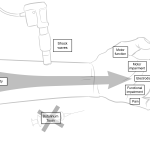Ever feel like your body has a mind of its own? Your heart races before a big meeting. Your stomach knots up during an argument. That, my friend, is your autonomic nervous system (ANS) in action. It’s the silent, behind-the-scenes operator running your body’s essential functions—heart rate, digestion, breathing—without you even thinking about it.
And honestly, in our fast-paced, always-on world, it’s no wonder this system gets stuck in high-alert mode. The good news? You have a direct line to it. Your breath. It’s the one automatic function you can easily take manual control of. By using specific breathwork techniques for autonomic nervous system regulation, you can essentially hack your body’s internal state, shifting from stressed to serene.
Understanding Your Body’s Autopilot: Sympathetic vs. Parasympathetic
Before we dive into the techniques, let’s get a quick handle on the two main players in the ANS. Think of them as an accelerator and a brake.
| The Sympathetic Nervous System (SNS) | The Parasympathetic Nervous System (PNS) |
| Your “Fight-or-Flight” response. The gas pedal. It revs you up for action in the face of perceived danger. | Your “Rest-and-Digest” response. The brake. It slows everything down, promoting recovery, calm, and healing. |
The goal of nervous system regulation isn’t to eliminate the SNS—we need it to get out of bed and meet deadlines!—but to prevent it from dominating the show. Breathwork is the most accessible tool to gently apply that brake and invite the calming parasympathetic nervous system back online.
Your Breathwork Toolkit: Techniques to Try
Alright, here’s the practical part. These techniques range from super simple to slightly more structured. The key is to experiment and see what feels right for your body.
1. The Foundation: Diaphragmatic Breathing (Belly Breathing)
This is where everyone should start. Most of us, especially when stressed, take shallow breaths into our chest. Belly breathing retrains you to breathe deeply, fully engaging the diaphragm and stimulating the vagus nerve—a superhighway to the parasympathetic system.
How to do it:
- Sit comfortably or lie on your back. Place one hand on your chest and the other on your belly.
- Inhale slowly through your nose for a count of 4, feeling your belly rise. Your chest should stay relatively still.
- Exhale slowly through your mouth (or nose) for a count of 6, feeling your belly fall.
- Repeat for 5-10 cycles. Seriously, that’s it. The magic is in the extended exhale.
2. The Quick Calm: The 4-7-8 Breathing Technique
Popularized by Dr. Andrew Weil, this is a powerhouse for instant relaxation. It’s almost like a tranquilizer for your nervous system. It’s fantastic for falling asleep or stopping an anxiety spiral in its tracks.
How to do it:
- Exhale completely through your mouth, making a soft “whoosh” sound.
- Close your mouth and inhale quietly through your nose for a count of 4.
- Hold your breath for a count of 7.
- Exhale completely through your mouth for a count of 8.
- This is one breath. Repeat the cycle three more times (four breaths total).
3. For Energy and Focus: Box Breathing (Square Breathing)
This technique is a favorite among athletes, military personnel, and, well, anyone who needs to stay cool under pressure. It’s balanced and grounding. Instead of a long exhale to induce calm, it uses equal parts, which can help with focus and emotional regulation without making you sleepy.
How to do it:
- Inhale through your nose for a count of 4.
- Hold your breath for a count of 4.
- Exhale through your nose for a count of 4.
- Hold the exhale (with your lungs empty) for a count of 4.
- Repeat for several minutes.
Why This Works: The Science of Sighing
You know that spontaneous sigh you take when you’re relieved or overwhelmed? It turns out your body is genius. A study from Stanford University identified that these sighs are actually a built-in reset button for the lungs and, by extension, your emotional state. Intentional sighing mimics this natural mechanism.
Cyclic Sighing: A simple, research-backed method.
- Inhale slowly through the nose until your lungs are about halfway full.
- Pause briefly.
- Then, take a second, sharper inhale through the nose to fully fill your lungs.
- Exhale slowly and fully through your mouth, making the exhale longer than the two inhales combined.
- Repeat for just five minutes. The study found this was more effective than mindfulness meditation at reducing stress.
Weaving Breathwork into Your Chaotic Day
The biggest hurdle isn’t learning the techniques—it’s remembering to use them. You don’t need a 30-minute meditation cushion. The beauty of breathwork for ANS regulation is its micro-dosing potential.
- At your desk: Try two minutes of box breathing between tasks.
- In traffic: Belly breathing at red lights can transform road rage into… well, tolerable stillness.
- Before sleep: Three rounds of 4-7-8 breathing while lying in bed.
- During a tough conversation: A single, conscious cyclic sigh can give you the pause you need to respond, not react.
The goal is consistency, not perfection. Even a few conscious breaths signal to your nervous system that you’re safe. That’s the core of it all—safety.
A Final Thought: Your Breath as an Anchor
In a world that constantly pulls our attention outward, the breath is an anchor to the present moment within. It’s a resource that’s always available, free, and incredibly powerful. These breathwork techniques for autonomic nervous system regulation aren’t about achieving some perfect state of zen. They’re about giving yourself agency. They’re a reminder that amidst the chaos, you have a say in how your body responds. You hold the key to your own internal climate control. So the next time you feel that familiar surge of stress, remember—the simplest tool is already with you. Just take a breath.











